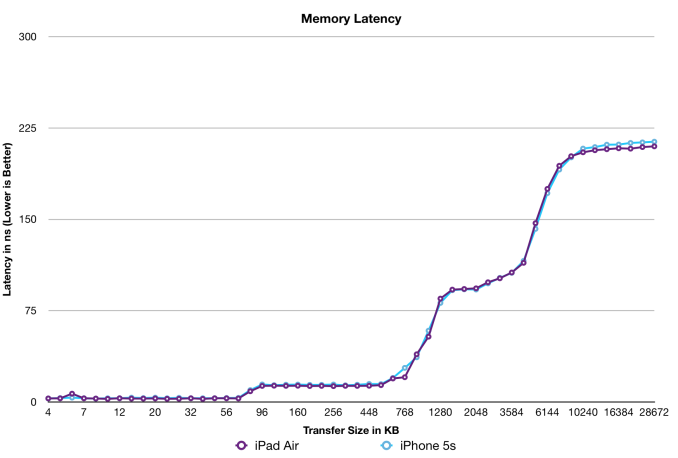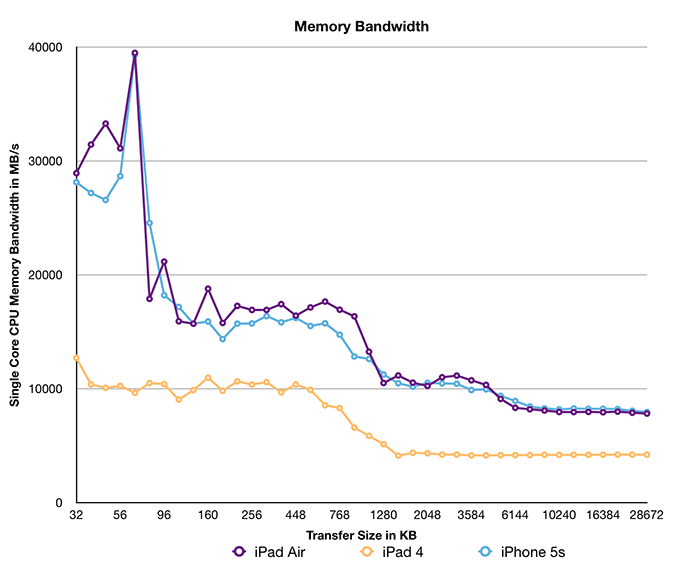The iPad Air Review
by Anand Lal Shimpi on October 29, 2013 9:00 PM ESTAn Update on Apple’s A7: It's Better Than I Thought
When I reviewed the iPhone 5s I didn’t have much time to go in and do the sort of in-depth investigation into Cyclone (Apple’s 64-bit custom ARMv8 core) as I did with Swift (Apple’s custom ARMv7 core from A6) the year before. I had heard rumors that Cyclone was substantially wider than its predecessor but I didn’t really have any proof other than hearsay so I left it out of the article. Instead I surmised in the 5s review that the A7 was likely an evolved Swift core rather than a brand new design, after all - what sense would it make to design a new CPU core and then do it all over again for the next one? It turns out I was quite wrong.
Armed with a bit of custom code and a bunch of low level tests I think I have a far better idea of what Apple’s A7 and Cyclone cores look like now than I did a month ago. I’m still toying with the idea of doing a much deeper investigation into A7, but I wanted to share some of my findings here.
The first task is to understand the width of the machine. With Swift I got lucky in that Apple had left a bunch of public LLVM documentation uncensored, referring to Swift’s 3-wide design. It turns out that although the design might be capable of decoding, issuing and retiring up to three instructions per clock, in most cases it behaved like a 2-wide machine. Mix FP and integer code and you’re looking at a machine that’s more like 1.5 instructions wide. Obviously Swift did very well in the market and its competitors at the time, including Qualcomm’s Krait 300, were similarly capable.
With Cyclone Apple is in a completely different league. As far as I can tell, peak issue width of Cyclone is 6 instructions. That’s at least 2x the width of Swift and Krait, and at best more than 3x the width depending on instruction mix. Limitations on co-issuing FP and integer math have also been lifted as you can run up to four integer adds and two FP adds in parallel. You can also perform up to two loads or stores per clock.
I don’t yet have a good understanding of the number of execution ports and how they’re mapped, but Cyclone appears to be the widest ARM architecture we’ve ever seen at this point. I’m talking wider than Qualcomm’s Krait 400 and even ARM’s Cortex A15.
I did have some low level analysis in the 5s review, where I pointed out the significantly reduced memory latency and increased bandwidth to the A7. It turns out that I was missing a big part of the story back then as well…
A Large System Wide Cache
In our iPhone 5s review I pointed out that the A7 now featured more computational GPU power than the 4th generation iPad. For a device running at 1/8 the resolution of the iPad, the A7’s GPU either meant that Apple had an application that needed tons of GPU performance or it planned on using the A7 in other, higher resolution devices. I speculated it would be the latter, and it turns out that’s indeed the case. For the first time since the iPad 2, Apple once again shares common silicon between the iPhone 5s, iPad Air and iPad mini with Retina Display.
As Brian found out in his investigation after the iPad event last week all three devices use the exact same silicon with the exact same internal model number: S5L8960X. There are no extra cores, no change in GPU configuration and the biggest one: no increase in memory bandwidth.
Previously both the A5X and A6X featured a 128-bit wide memory interface, with half of it seemingly reserved for GPU use exclusively. The non-X parts by comparison only had a 64-bit wide memory interface. The assumption was that a move to such a high resolution display demanded a substantial increase in memory bandwidth. With the A7, Apple takes a step back in memory interface width - so is it enough to hamper the performance of the iPad Air with its 2048 x 1536 display?
The numbers alone tell us the answer is no. In all available graphics benchmarks the iPad Air delivers better performance at its native resolution than the outgoing 4th generation iPad (as you'll soon see). Now many of these benchmarks are bound more by GPU compute rather than memory bandwidth, a side effect of the relative lack of memory bandwidth on modern day mobile platforms. Across the board though I couldn’t find a situation where anything was smoother on the iPad 4 than the iPad Air.
There’s another part of this story. Something I missed in my original A7 analysis. When Chipworks posted a shot of the A7 die many of you correctly identified what appeared to be a 4MB SRAM on the die itself. It's highlighted on the right in the floorplan diagram below:

A7 Floorplan, Courtesy Chipworks
While I originally assumed that this SRAM might be reserved for use by the ISP, it turns out that it can do a lot more than that. If we look at memory latency (from the perspective of a single CPU core) vs. transfer size on A7 we notice a very interesting phenomenon between 1MB and 4MB:
That SRAM is indeed some sort of a cache before you get to main memory. It’s not the fastest thing in the world, but it’s appreciably quicker than going all the way out to main memory. Available bandwidth is also pretty good:
We’re only looking at bandwidth seen by a single CPU core, but even then we’re talking about 10GB/s. Lookups in this third level cache don’t happen in parallel with main memory requests, so the impact on worst case memory latency is additive unfortunately (a tradeoff of speed vs. power).
I don’t yet have the tools needed to measure the impact of this on-die memory on GPU accesses, but in the worst case scenario it’ll help free up more of the memory interface for use by the GPU. It’s more likely that some graphics requests are cached here as well, with intelligent allocation of bandwidth depending on what type of application you’re running.
That’s the other aspect of what makes A7 so very interesting. This is the first Apple SoC that’s able to deliver good amounts of memory bandwidth to all consumers. A single CPU core can use up 8GB/s of bandwidth. I’m still vetting other SoCs, but so far I haven’t come across anyone in the ARM camp that can compete with what Apple has built here. Only Intel is competitive.












444 Comments
View All Comments
Kvaern - Wednesday, October 30, 2013 - link
You bought a first generation tech device and if you expected that to bring solid performance to the table for 5-8 years then I'm afraid it's your expectations that are the issue at hand, not the device.aliasfox - Wednesday, October 30, 2013 - link
Well, I knew I should've waited for the iPad 2, but I was taking a long trip in the fall of 2010 and it was by far the best option for internet connectivity at the time.As for 5-8 years... well, it's more that I expect $700 to last me longer. All of my other 3-4 yr old devices may be beat up, slow, and not great, but unlike the iPad 1 (on iOS5), they are still reasonably usable.
zogus - Wednesday, October 30, 2013 - link
As an owner of iPad 1 who've found the lack of iOS 6 update frustrating, I understand your sentiment completely, and I'm kind of on the fence myself regarding the new iPads.There is one major difference between the iPad 1 situation and iPad Air, however: iPad 1 was followed less than three months later by iPhone 4, which had twice as much RAM, at which point anyone remotely tech-y could see the writing on the wall. iPad Air is not likely to have that kind of upstaging for a couple of years since iPhone 5S is still brand new, and the large number of 512MB units (iPhone 4/4S, iPad 2, iPad mini) need to be taken off the market first. Apple cannot afford to bloat iOS to the point where 1GB is insufficient for a some years to come.
aliasfox - Wednesday, October 30, 2013 - link
At the time the iPad 1 came out, it had equivalent RAM to the (then top of the line) 3GS, and twice as much as the first two iPhones and first few generations if iPod Touches. Granted, between the iPad 2/3, iPhone 4/4s, and iPad mini they've sold a boatload more 512MB devices, but the difference is a matter of scale.akdj - Wednesday, October 30, 2013 - link
Yet with an A7 device (iPhone 5s/iPad Air/iPad mini w/retina) one can now run 32 tracks in Garage Band vs. 16 on the same memory 'starved' iPad 4? More memory will come...it's a non-isssue. The iPad 2 is now in the hands of 10s of thousands of pilots on commercial airlines. Their Jep Charts and approach plates...user manuals and updates to said charts and plates work just fine.Guys/Gals....this isn't Windows. This isn't Android. Apple's conservative RAM approach significantly improves battery life...and doesn't at all seem to affect actually running currently available apps that haven't been built with iOS7 in mind, much less 64bit programming! The vast majority of apps currently available are optimized to the A5 processor with 512mb of RAM. You'll be fine...I know I sure am on both my iPad 4 and iPhone 5s. If you need 10 tabs open on Safari while manipulating photos and listening to music, buy a laptop!
stacey94 - Wednesday, October 30, 2013 - link
Isn't RAM fairly cheap anyway? It's not consuming that much power either. I don't understand the logic behind skimping on it.Spunjji - Tuesday, November 5, 2013 - link
Planned obsolescence. Simple as that.nedjinski - Tuesday, October 29, 2013 - link
Kindle Fire HDX 8.9 still beats it - sorry.Fly Molo - Tuesday, October 29, 2013 - link
...That just happened.dragonsqrrl - Wednesday, October 30, 2013 - link
...yep, unfortunately